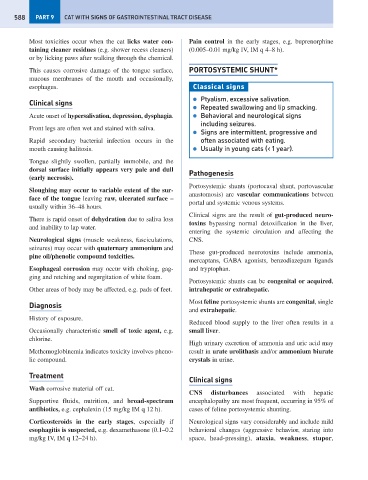Page 596 - Problem-Based Feline Medicine
P. 596
588 PART 9 CAT WITH SIGNS OF GASTROINTESTINAL TRACT DISEASE
Most toxicities occur when the cat licks water con- Pain control in the early stages, e.g. buprenorphine
taining cleaner residues (e.g. shower recess cleaners) (0.005–0.01 mg/kg IV, IM q 4–8 h).
or by licking paws after walking through the chemical.
This causes corrosive damage of the tongue surface, PORTOSYSTEMIC SHUNT*
mucous membranes of the mouth and occasionally,
esophagus. Classical signs
● Ptyalism, excessive salivation.
Clinical signs
● Repeated swallowing and lip smacking.
Acute onset of hypersalivation, depression, dysphagia. ● Behavioral and neurological signs
including seizures.
Front legs are often wet and stained with saliva.
● Signs are intermittent, progressive and
Rapid secondary bacterial infection occurs in the often associated with eating.
mouth causing halitosis. ● Usually in young cats (< 1 year).
Tongue slightly swollen, partially immobile, and the
dorsal surface initially appears very pale and dull
Pathogenesis
(early necrosis).
Portosystemic shunts (portocaval shunt, portovascular
Sloughing may occur to variable extent of the sur-
anastomosis) are vascular communications between
face of the tongue leaving raw, ulcerated surface –
portal and systemic venous systems.
usually within 36–48 hours.
Clinical signs are the result of gut-produced neuro-
There is rapid onset of dehydration due to saliva loss
toxins bypassing normal detoxification in the liver,
and inability to lap water.
entering the systemic circulation and affecting the
Neurological signs (muscle weakness, fasciculations, CNS.
seizures) may occur with quaternary ammonium and
These gut-produced neurotoxins include ammonia,
pine oil/phenolic compound toxicities.
mercaptans, GABA agonists, benzodiazepam ligands
Esophageal corrosion may occur with choking, gag- and tryptophan.
ging and retching and regurgitation of white foam.
Portosystemic shunts can be congenital or acquired,
Other areas of body may be affected, e.g. pads of feet. intrahepatic or extrahepatic.
Most feline portosystemic shunts are congenital, single
Diagnosis
and extrahepatic.
History of exposure.
Reduced blood supply to the liver often results in a
Occasionally characteristic smell of toxic agent, e.g. small liver.
chlorine.
High urinary excretion of ammonia and uric acid may
Methemoglobinemia indicates toxicity involves pheno- result in urate urolithasis and/or ammonium biurate
lic compound. crystals in urine.
Treatment
Clinical signs
Wash corrosive material off cat.
CNS disturbances associated with hepatic
Supportive fluids, nutrition, and broad-spectrum encephalopathy are most frequent, occurring in 95% of
antibiotics, e.g. cephalexin (15 mg/kg IM q 12 h). cases of feline portosystemic shunting.
Corticosteroids in the early stages, especially if Neurological signs vary considerably and include mild
esophagitis is suspected, e.g. dexamethasone (0.1–0.2 behavioral changes (aggressive behavior, staring into
mg/kg IV, IM q 12–24 h). space, head-pressing), ataxia, weakness, stupor,

